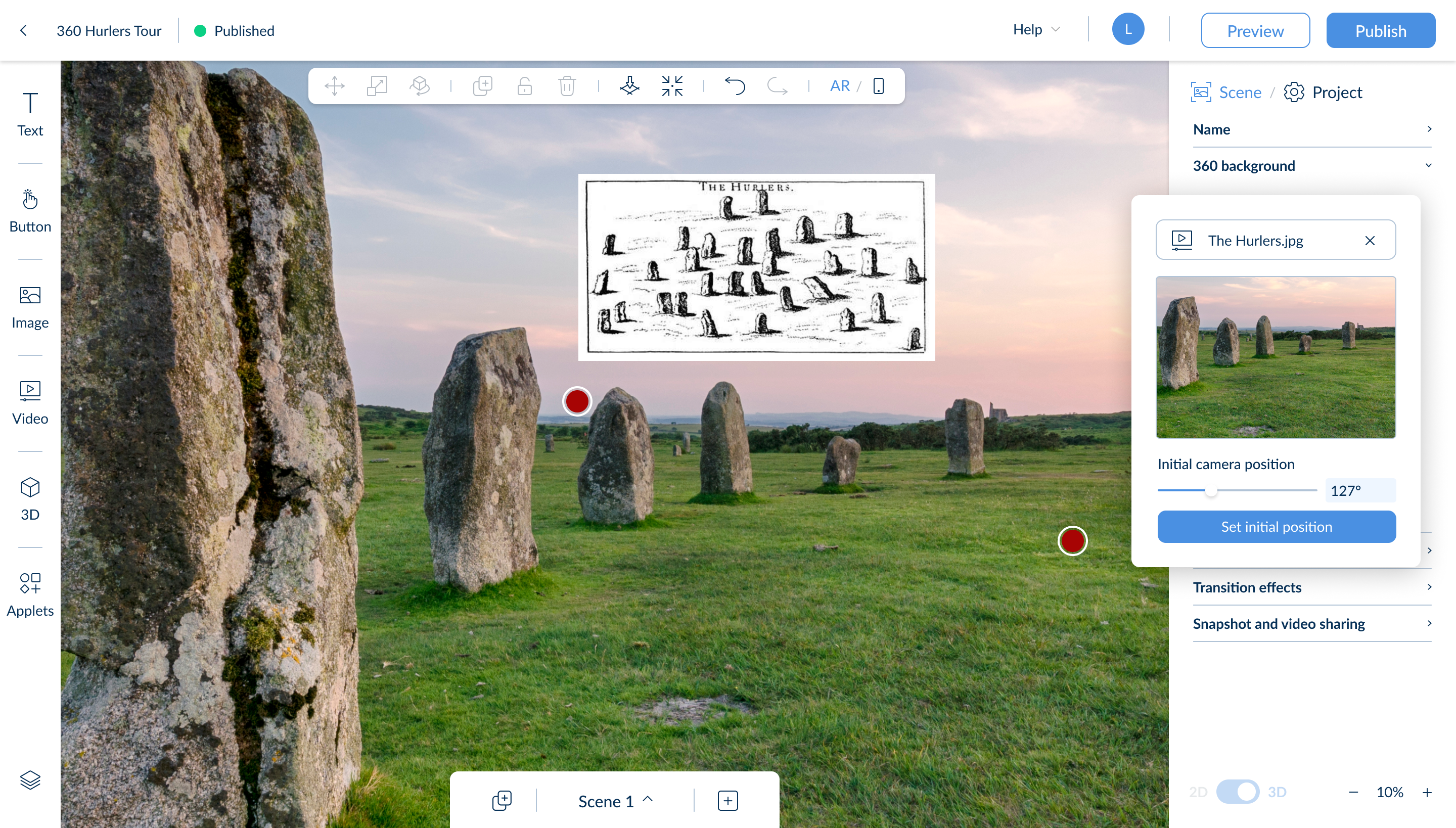When it comes to immersive storytelling, using 360° video and images can bring a whole new dimension to your augmented reality (AR) or mixed reality (MR) experiences. They allow users to explore environments from any angle, creating a rich, interactive experience that can be applied across industries.
With the introduction of 360 Images and video backgrounds in our no-code tool, Designer, it's now easier than ever to use them to enhance engagement, drive innovation, and deliver unforgettable experiences.
Here are 5 ways you can utilise 360 assets in your immersive experiences:
1. Using 360 for virtual tourism and real estate tours

360° video or images with XR allow users to virtually explore a location as if they were physically present, whether a luxury home on the market or a must-see travel destination.
These experiences provide a fully immersive way for prospective buyers or tourists to explore a property or vacation spot from the comfort of their own space, walking through rooms, streets, or landscapes while engaging with additional AR layers, like pop-up information, maps, or booking options.
Key Benefits:
- Offers a fully immersive, 3D walk-through experience.
- Allows users to explore at their own pace.
- Incorporates AR layers like virtual furniture staging or local points of interest.
2. Using 360 for immersive training and education

360° video and images can bring a new level of realism to training and educational experiences. Industries such as healthcare, manufacturing, and aviation can benefit from the combination of XR and 360° environments by enabling employees to practise in lifelike scenarios without needing to be physically present.
For example, medical students can explore the interior of an operating room, while AR hotspots deliver additional instructions or detailed annotations about equipment and procedures.
For education, imagine taking students on a virtual field trip to a museum or historical landmark, where they can explore exhibits through a 360° view and interact with AR-powered facts, quizzes, or videos.
Key Benefits:
- Provides hands-on, risk-free training in simulated environments.
- Enhances engagement and retention in educational settings.
- Enables scalable, remote learning opportunities.
3. Using 360 for product demos and interactive marketing

Brands are always looking for fresh ways to connect with their audience. Whether it’s a new car model or the latest fashion line, using 360 assets, brands can create immersive experiences that let users virtually explore products from every angle.
With XR, brands can go beyond static demos or product tours adding AR annotations and immersive video with direct purchase links making it even easier for consumers to engage with products and make informed decisions.
Key Benefits:
- Offers an engaging, interactive product experience.
- Boosts consumer confidence with lifelike demonstrations.
- Increases conversions by incorporating in-experience purchasing.
4. Using 360 for entertainment and fan experiences

360° video and images in XR can transform entertainment and fan experiences by creating immersive, behind-the-scenes content, interactive story-driven environments, or themed virtual spaces.
For example, fans can explore exclusive 360° recreations of iconic movie sets, walk through virtual art exhibits inspired by their favourite franchises, or experience guided virtual tours of locations significant to a show’s storyline. AR elements like interactive hotspots, pop-up trivia, or mini-games can be added to these 360° environments, enhancing engagement and making the experience more personalised and memorable.
Key Benefits:
- Transports fans to interactive, 360° virtual environments inspired by their favourite franchises.
- Integrates AR layers like pop-up videos, trivia, and hidden surprises for a more engaging experience.
- Provides exclusive behind-the-scenes access and unique content that deepens fan engagement.
5. Using 360 in cultural heritage and museum experiences

Museums and cultural institutions can harness the power of 360° video and XR to create virtual tours and interactive exhibits, making cultural heritage accessible to a global audience.
Whether walking through ancient ruins or viewing historical artefacts, 360° media allows users to explore spaces from any location. Adding AR elements, such as information tags, video content, or even historical reconstructions, enhances the experience by layering rich storytelling into the virtual environment.
This technology also allows institutions to preserve fragile or inaccessible sites, making them digitally available for generations to explore without the risks of physical degradation.
Key Benefits:
- Expands access to cultural sites and exhibits globally.
- Enhances storytelling with AR annotations and reconstructions.
- Preserves and digitises cultural heritage.
Final thoughts
The combination of 360° video and images with AR opens up limitless opportunities to create immersive, interactive experiences across various industries. Whether exploring new locations, training in lifelike environments, or engaging with products in innovative ways, this powerful duo enables brands, educators, and organisations to bring their content to life in exciting, meaningful ways.
Incorporating 360° media into your projects can provide an edge in delivering richer, more engaging experiences that captivate and inspire users.
Explore the possibilities and start creating your own immersive AR experiences today in Designer by starting a free 14-day trial and using one of the 360 templates.
 Grace Vassallo
Grace VassalloSenior Brand & Marketing Manager, Zappar
